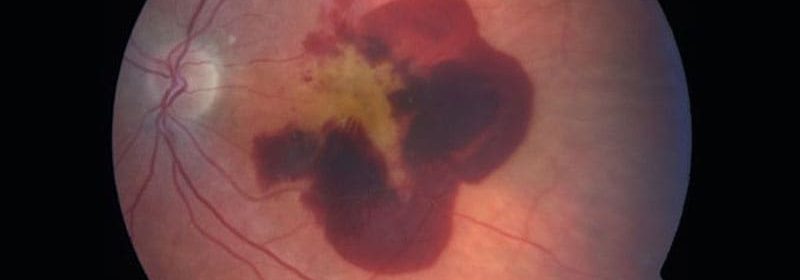High-Dose Aflibercept Sustains Outcomes Over 96 Weeks

The high-dose 8-mg formulation of aflibercept, approved by the US Food and Drug Administration in August, has been shown to sustain improvement in visual acuity as well as retinal anatomy out to 22 months on par with every-other-month treatment with the original 2-mg dose, but with up to 36% fewer injections.
Results from the PULSAR randomized clinical trial that compared 2- and 8-mg doses of the drug showed that 89% of the patients who received the higher dose achieved at least every-3-month dosing and 78% achieved every-4-month dosing at the 96-month mark, Paolo Lanzetta, MD, of the University of Udine in Udine, Italy, reported at EURETINA 2023.
“Aflibercept 8 mg has the potential for greater and longer-lasting control of neovascular age-related macular degeneration compared with aflibercept 2 mg through sustained disease control,” Lanzetta told Medscape Medical News. “Extended treatment intervals in neovascular age-related macular degeneration [nAMD] could offer a marked reduction in treatment burden.”
PULSAR consisted of three treatment arms: 2 mg of aflibercept every 8 weeks (2q8; n = 336); 8 mg of aflibercept every 12 weeks (8q12; n = 335); or 8 mg of aflibercept every 16 weeks (8q16; n = 338). Each arm started therapy with three monthly doses of the assigned treatment.
96-Week Results
The previously reported primary endpoint of PULSAR at 48 weeks showed noninferiority of the 8-mg to the 2-mg dose. The 60- and 96-week results that Lanzetta shared at EURETINA 2023 showed that 91.5% of all patients in PULSAR completed the 60-week readout, with an average discontinuation rate of 7.9% before 60 weeks.
All three arms showed similar improvement and maintenance of best-corrected visual acuity (BCVA) at 48, 60, and 96 weeks, with gains measured in Early Treatment Diabetic Retinopathy Study (ETDRS) letters of 7, 6.1, and 5.9 in the 2q8, 8q12, and 8q16 treatment arms at 48 weeks; 7.2, 6.4, and 6.3 letters at 60 weeks; and 6.6, 5.6, and 5.5 letters at 96 weeks, Lanzetta told meeting attendees.
Improvement in central retinal subfield thickness (CST), measured as a reduction on optical coherence tomography (OCT), followed a similar trajectory: reductions of 136 µm in the 2q8 arm and 147 µm in the 8q12 and 8q16 arms at 48 weeks; 155, 154, and 151 µm at 60 weeks; and 147, 152, and 149 µm at 96 weeks, Lanzetta reported.
Rates of adverse events related to treatment were comparable across the 2q8, 8q12, and 8q16 arms through 96 weeks, with 45.2%, 42.4%, and 42.3% of patients reporting at least one such event, he said.
“Vision gains achieved with aflibercept 8 mg were comparable to that of aflibercept 2 mg, with fewer injections in the 8-mg arms — 9.7 in the q12 arm and 8.2 in the q16 arm — compared with 2-mg [12.8] at week 96,” Lanzetta told Medscape.
New Treatment Paradigms?
“This study has unprecedented findings with respect to injectable anti-VEGF agents,” Lanzetta said. “It proves sustained disease control by extending intervals between injections to durations never seen before.”
At week 96, almost 30% of patients on either 8q12 or 8q16 achieved a last-assigned treatment interval of q24, he said. “More than 50% of patients assigned to 8q16 had a last assigned interval of at least q20,” Lanzetta added. “This means that a relevant proportion of our patients may receive an injection of aflibercept 8 mg every 6 months.”
Such extended intervals between injections would challenge clinicians to rethink their treatment approaches, he said.
“It is likely that we will have to introduce newer strategies to monitor patients with very long pauses between treatments in order to promptly intercept any signs of recurrences and administer injections as early as possible when needed,” Lanzetta said. “Self-monitoring with newer aids such as apps for smart phones or home OCT as recently proposed are being studied.”
A strength of PULSAR is that it used strict criteria for shortening treatment intervals: a 5-letter loss or an increase of 25 µm in CST or new retinal hemorrhage, Gabriel Katz, MD, chair of the Israeli Retina Society and director of the vitreoretinal service at Goldschleger Eye Institute at Sheba Medical Center in Tel HaShomer, Israel, told Medscape.
But the strict use of every-other-month dosing of 2-mg aflibercept is a potential limitation, Katz noted. “It was shown before that even aflibercept 2 mg can be used in a treat-and-extend manner with a quite significant proportion of patients on q12,” he said.
He also noted that in real-life practice, few retina specialists will wait for vision loss, such as a five-letter reduction in BCVA, before treating a patient who shows CST loss on OCT.
“The 90-week results are not surprising,” Katz said. “It seems that aflibercept 8 mg works nicely, and the proportion of patients on q12 and more were similar in the second and first years. Some of them were extended to 16, 20, and 24 weeks in the second year, which is very impressive. In real life, if ETDRS charts are not routinely used, a five-letter loss in BCVA may be easily undetected.”
The PULSAR study was sponsored by Bayer and Regeneron Pharmaceuticals. Lanzetta disclosed relationships with Bayer, Boehringer Ingelheim, Genentech/Roche, Novartis and Outlook Therapeutics. Katz participated in the PULSAR study and served as a consultant to Bayer.
European Society of Retina Specialists (EURETINA) 2023 annual meeting. Lanzetta P. Free Paper Session 3: Intravitreal aflibercept 8 mg injection in patients with neovascular age-related macular degeneration: 60-week results from the phase 3 PULSAR trial. Presented October 5, 2023.
Richard Mark Kirkner is a medical journalist based in the Philadelphia area.
For more news, follow Medscape on Facebook, X (formerly known as Twitter), Instagram, and YouTube
Source: Read Full Article